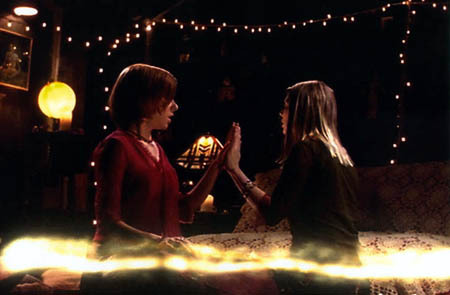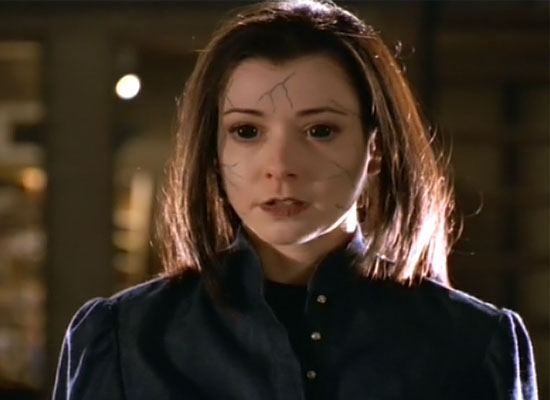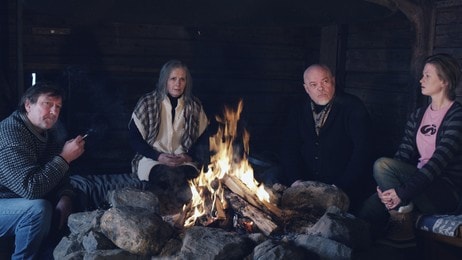Yes, it's cool that an American, more or less mainstream, tv show for teenagers featured a lesbian couple. But what does Joss Whedon's Buffy the Vampire Slayer really tell us about lesbians?
The main lesbian couple in the series is regular character Willow, and Tara who's on the show for a couple of seasons. By the time they meet, we have followed Willow since early high school, and seen her very long lasting crush on her best friend Xander, and after that her relationship with Oz. Both pretty "safe", traditional and straight relationships. Well, apart from Oz being a werewolf, but you know. In other words, we have come to know Willow as a normal young girl with normal drives. That is, until Oz breaks her straight little heart in pieces and she feels sure that she can never love again.
Enter Tara, the shy, weirdo outcast from the college (so called) Wicca group. She is quick to realise that she and Willow share their interest in actual magics (rather than just bake sales and scented candles like the rest of the group), and she first comes to Willow for help in some supernatural matter. We know straight away (no pun intended) that there is something a bit off about Tara. She even has a stutter, for crying out loud!
So social misfit Tara comforts heartbroken Willow, until they at one point realise that there might be something more than just straight girl friendship between them. The first time this is directly addressed, rather than just hinted at through shy looks passed between the girls, is when Oz briefly returns and shouts at Tara, IS SHE IN LOVE WITH YOU!? The ordeal of processing this is enough to turn the newly "fixed" or "healed" werewolf back into a furry ball of rage. Tara assumes that Willow will go back to Oz rather than be with a freak like herself. But Willow comes back to Tara, and promises to make up for everything. Starting right now. They blow out the candle and they disappear in the darkness.
Maybe romantic, yes, but also symptomatic of something. It's like Whedon has to ease the viewers into the idea of an actual lesbian romance. I don't remember exactly the specific episode in which we first see Willow and Tara kiss, but it seems like an aweful long time after they become an item. Sure, the show as a whole is more innocent or easy on all the sexual stuff in the first couple of seasons while the Scooby gang are still in high school, but this is different. We've already seen Buffy get it on with at least two, if not three men; we've seen Willow and Xander get their smooch on which ends Xander's relationship with Cordelia; Willow has even been deflowered by Oz. And isn't it around the same time that Buffy and Rilley nearly get a lot of people killed by a possessed house, on account of all the hot and steamy sex they're constantly having? Yet it takes ages before we see just the smallest, most innocent kiss from Willow and Tara. Firmly established as a couple by then, most of their early kisses are securely grounded in the safety of casual, everyday moments. As if it were the most natural thing in the world, perhaps – or perhaps because it isn't safe to make an equally big deal out of the romance and lust of a pair of lesbians as what is done with their straight friends.
I guess that what bugs me most about the whole setup, though, is the fundamental connection with magic. As I have mentioned above, magic is what brings the two girls together. Which is fair enough, it's not as if they're the only ones on the show to have interests or hobbies of the somewhat supernatural kind. But just as straight sexuality is more than once in the series recognised by brutal, animal behaviour (vampires, werewolves, etc), lesbian romance and sexuality seems something that can only really exist in inscence-smelling, candle-lit rooms by girls clad in earthy tones, who communicate with godesses and do cute magic tricks with sparkly powders and so on. The magic, the fact that Tara and Willow have the power to communicate with powers outside of themselves which can allow them to bend the laws of nature at their will, makes sure that their lesbian relationship is thoroughly, unforgettably marked as unnatural. It's something for witches, not for normal people.
 |
| Theirs was a magic kind of love. |
Of course, this changes in the final season after Tara is out of the picture and another girl takes interest in Willow. But that girl is so clearly only interested in sex, and in being socially controlling, that I'm not sure how much better that works out.
Anyway.
The magic does get too much for Tara as well, eventually. Willow starts using magic for every little thing that she could have just as easily taken care of otherwise – like searching through books or on the computer for information, or pulling the curtains shut. When Willow clearly can't go even a week without using magic, Tara leaves her. I'm unsure if this fits into the whole symbolic thing. One way of looking at it could be, if we think of magic as one of the biggest markers of their lesbianism, that Tara wishes Willow wouldn't flaunt it so much. She might feel that it's more of a private thing, and resents Willow for making it extremely public, without taking her girlfriend's feelings into consideration. Which would basically tell us that public lesbianism is bad, mmkay?
After some time apart, Willow manages to get her powers under control again, and the couple find their way back to each other. Their relationship is more explicit onscreen now, but mainly within the confines of their own bedroom.
Then, the tragedy. Tara dies, from a gunshot that was meant for Buffy. Whatever kind of control Willow had got back, that and much more is instantly lost. She becomes an evil Super Witch and tries to end the world. She did for a moment turn to magic when things ended with her and Oz as well, but never anything like this. After all, she was a straight little girl back then, and her Magic Lesbian Superpowers weren't fully developed. But now we see what a long-term lesbian relationship has done to Willow, once the tiny geeky cutiepie. A lot happens, but the highlights include her fighting, both physically and psychologically, all of her best friends; she kills a man (Tara's killer) in a pretty gruesome way; and she does try to end the entire world, before good old Xander, her first crush and life-long best friend, comes along and sweet talks her out of it. Basically. But narrated in a more dramatic way than that, as I'm sure you can imagine.
 |
| You don't wanna mess with this heartbroken lesbian. |
When Kennedy, the other girl that I mentioned above, who takes an interest in Willow, first gets her to play along with her flirting, Bad Willow seems to reappear. She suddenly inhabits the body of Warren, Tara's killer, and gradually turns into him mentally as well. (S)he goes right out and buys a gun and plans to kill the evil lesbian that made her do the smoochies with her. Which was the exact moment that Willow physically turned into a man, by the way – when they first kissed. But no one is killed this time around (although Willow blames herself for "killing" Tara by letting her go), as Kennedy manages to remind Willow that she is her, a woman, not a crazy blood-thirsty man. Several make-out sessions ensue, in front of people and everything, so at least that's a good thing.
It's not as if Whedon's lesbians are made out to be horrible people, and I don't think that Whedon especially dislikes lesbians. But maybe this can serve as an example of how easy it is to misrepresent something with pretty comically bad consequences. In this case though, no one, no matter what sexual orientation or gender, gets off pretty easy. Too many demons in Sunnydale for that.















